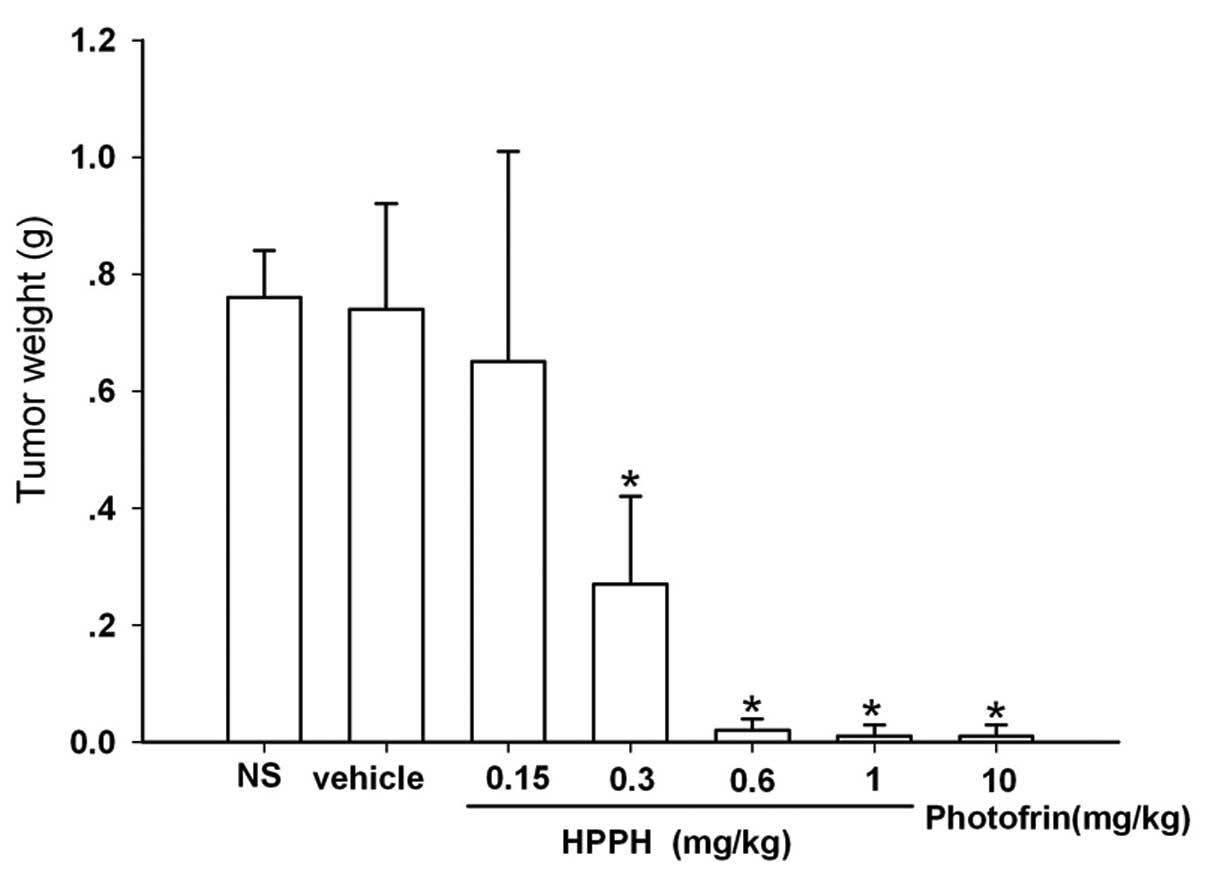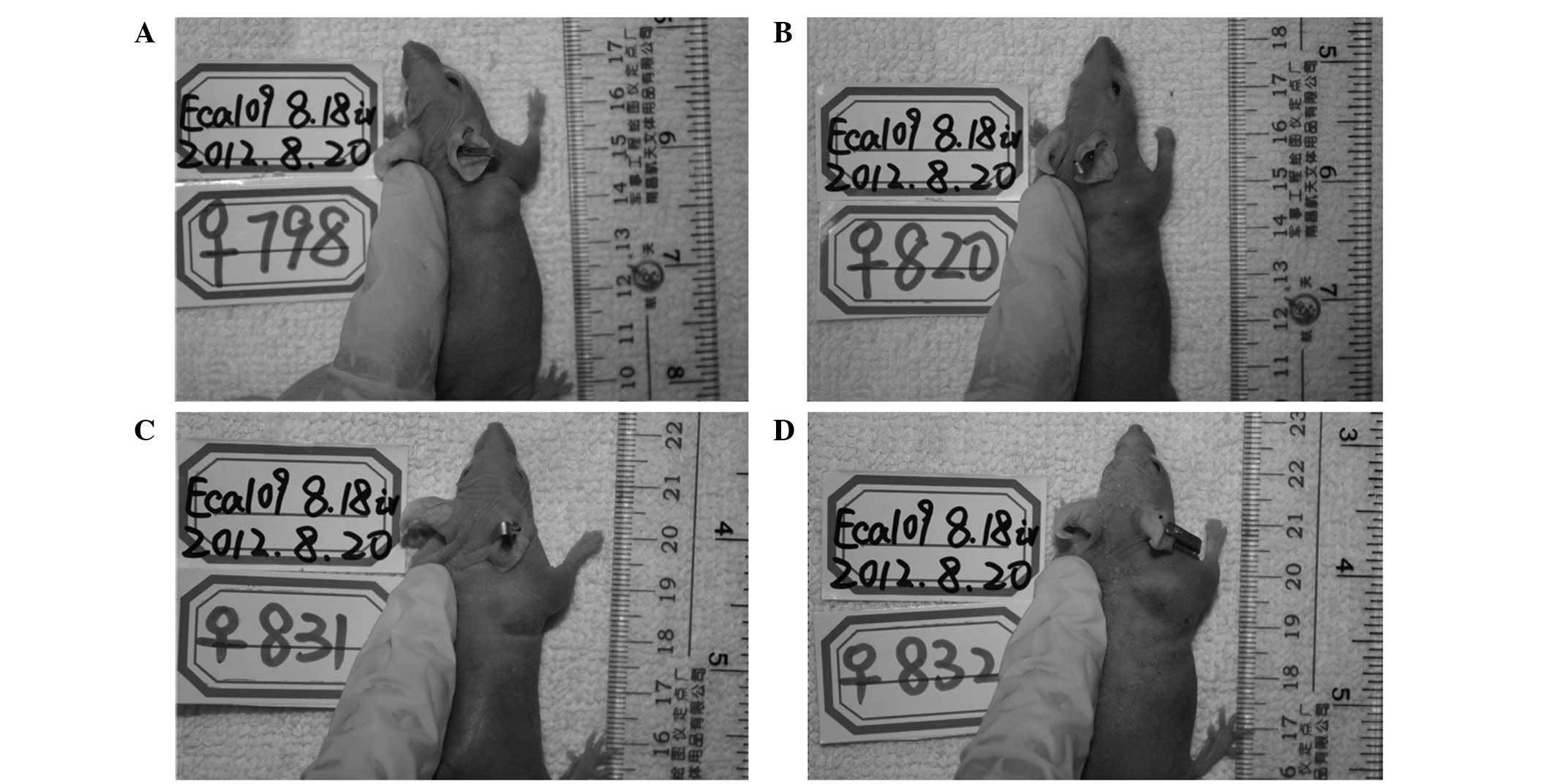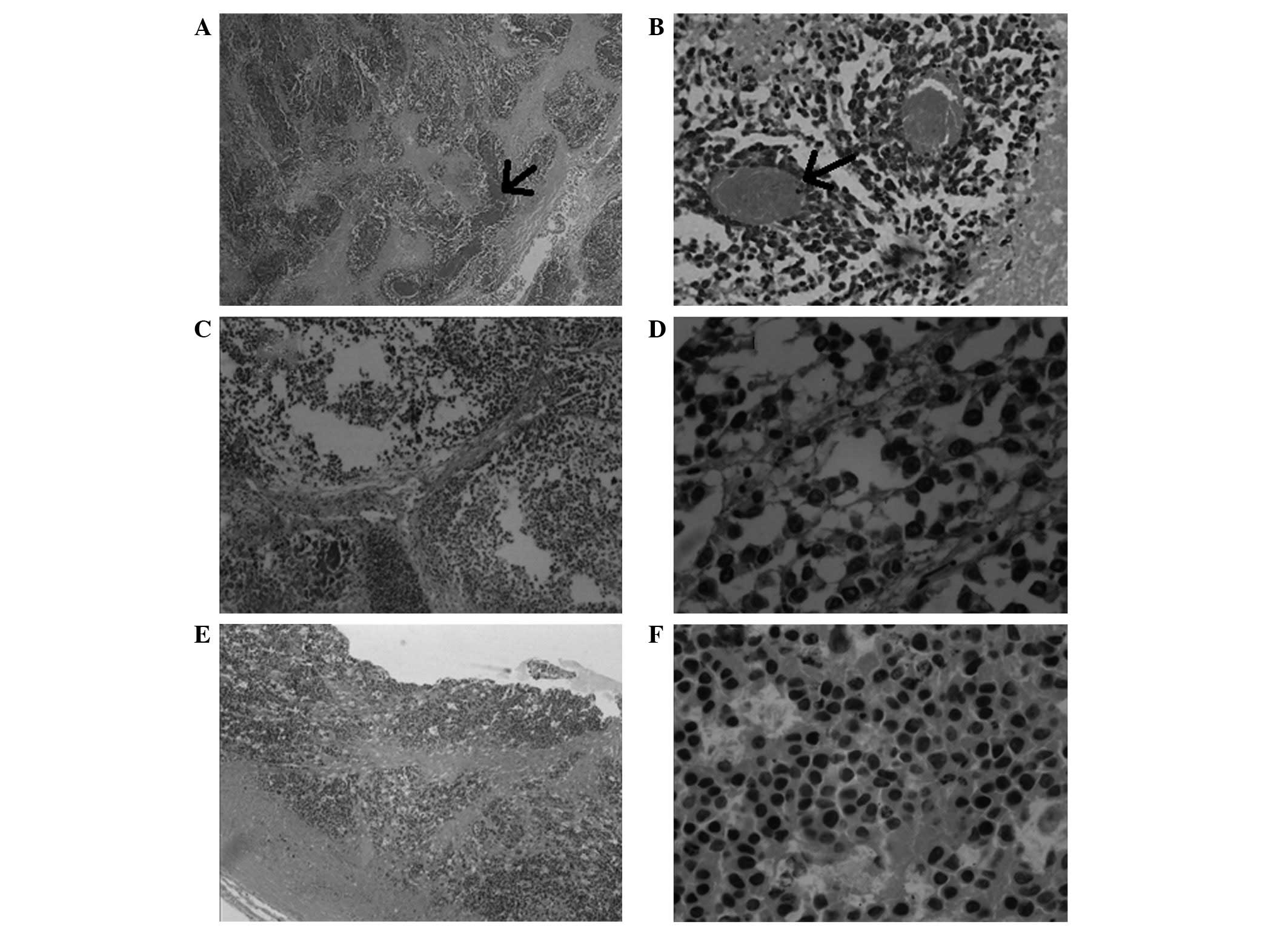|
1
|
Song C, Xing D, Tan W, Wei Q and Lin D:
Methylenetetrahydrofolate reductase polymorphisms increase risk of
esophageal squamous cell carcinoma in a Chinese population. Cancer
Res. 61:3272–3275. 2001.PubMed/NCBI
|
|
2
|
Fink U, Stein HJ and Siewert JR:
Multimodal therapy of tumors of the upper gastrointestinal tract.
Chirurg. 69:349–359. 1998.(In German).
|
|
3
|
Siewert JR and Hölscher AH: Current
strategy in surgery for esophageal cancer. Ann Ital Chir. 63:13–18.
1992.PubMed/NCBI
|
|
4
|
Li SY, Sun XC and Liu L: Progress of
medical and combined treatment for esophageal carcinoma. Ai Zheng.
25:509–515. 2006.(In Chinese).
|
|
5
|
Dougherty TJ, Gomer CJ, Henderson BW, Jori
G, Kessel D, Korbelik M, Moan J and Peng Q: Photodynamic therapy. J
Natl Cancer Inst. 90:889–905. 1998. View Article : Google Scholar
|
|
6
|
Webber J, Herman M, Kessel D and Fromm D:
Current concepts in gastrointestinal photodynamic therapy. Ann
Surg. 230:12–23. 1999. View Article : Google Scholar : PubMed/NCBI
|
|
7
|
Sibille A, Lambert R, Souquet JC, Sabben G
and Descos F: Long-term survival after photodynamic therapy for
esophageal cancer. Gastroenterology. 108:337–344. 1995. View Article : Google Scholar : PubMed/NCBI
|
|
8
|
Allison RR, Downie GH, Cuenca R, Hu XH,
Childs Carter JH and Sibata Claudio H: Photosensitizers in clinical
PDT. Photodiagn Photodyn Ther. 1:27–42. 2004. View Article : Google Scholar
|
|
9
|
Pandey RK, Bellnier DA, Smith KM and
Dougherty TJ: Chlorin and porphyrin derivatives as potential
photosensitizers in photodynamic therapy. Photochem Photobiol.
53:65–72. 1991. View Article : Google Scholar : PubMed/NCBI
|
|
10
|
Henderson BW, Bellnier DA, Greco WR,
Sharma A, Pandey RK, Vaughan LA, Weishaupt KR and Dougherty TJ: An
in vivo quantitative structure-activity relationship for a
congeneric series of pyropheophorbide derivatives as
photosensitizers for photodynamic therapy. Cancer Res.
57:4000–4007. 1997.
|
|
11
|
Lee LK, Whitehurst C, Pantelides ML and
Moore JV: In situ comparison of 665 nm and 633 nm wavelength light
penetration in the human prostate gland. Photochem Photobiol.
62:882–886. 1995. View Article : Google Scholar : PubMed/NCBI
|
|
12
|
Bellnier DA, Henderson BW, Pandey RK,
Potter WR and Dougherty TJ: Murine pharmacokinetics and antitumor
efficacy of the photodynamic sensitizer
2-T1-hexyloxyethyl]-2-devinyl pyropheophorbide-a. J Photochem
Photobiol B. 20:55–61. 1993.PubMed/NCBI
|
|
13
|
Bellnier DA, Greco WR, Loewen GM, Nava H,
Oseroff AR, Pandey RK, Tsuchida T and Dougherty TJ: Population
pharmacokinetics of the photodynamic therapy agent
2-[1-hexyloxyethyl]-2-devinyl pyropheophorbide-a in cancer
patients. Cancer Res. 63:1806–1813. 2003.
|
|
14
|
Srivatsan A, Ethirajan M, Pandey SK, Dubey
S, Zheng X, Liu TH, Shibata M, Missert J, Morgan J and Pandey RK:
Conjugation of cRGD peptide to chlorophyll a based photosensitizer
(HPPH) alters its pharmacokinetics with enhanced tumor-imaging and
photosensitizing (PDT) efficacy. Mol Pharm. 8:1186–1197. 2011.
View Article : Google Scholar : PubMed/NCBI
|
|
15
|
Fingar VH, Wieman TJ and Haydon PS: The
effects of thrombocytopenia on vessel stasis and macromolecular
leakage after photodynamic therapy using photofrin. Photochem
Photobiol. 66:513–517. 1997. View Article : Google Scholar : PubMed/NCBI
|
|
16
|
Sancéau J, Poupon MF, Delattre O,
Sastre-Garau X and Wietzerbin J: Strong inhibition of Ewing tumor
xenograft growth by combination of human interferon-alpha or
interferon-beta with ifosfamide. Oncogene. 21:7700–7709. 2002.
|
|
17
|
Bissery MC, Guenard D, Guéritte-Voegelein
F and Lavelle F: Experimental antitumor activity of taxotere (RP
56976, NSC 628503), a taxol analogue. Cancer Res. 51:4845–4852.
1991.PubMed/NCBI
|
|
18
|
Hajri A, Wack S, Meyer C, Smith MK,
Leberquier C, Kedinger M and Aprahamian M: In vitro and in vivo
efficacy of photofrint and pheophorbide a, a bacteriochlorin, in
photodynamic therapy of colonic cancer cells. Photochem Photobiol.
75:140–148. 2002. View Article : Google Scholar : PubMed/NCBI
|
|
19
|
Zheng X, Morgan J, Pandey SK, Chen Y,
Tracy E, Baumann H, Missert JR, Batt C, Jackson J, Bellnier DA,
Henderson BW and Pandey RK: Conjugation of
2-(1′-hexyloxyethyl)-2-devinylpyropheophorbide-a (HPPH) to
carbohydrates changes its subcellular distribution and enhances
photodynamic activity in vivo. J Med Chem. 52:4306–4318. 2009.
|
|
20
|
Gomer CJ, Ferrario A, Hayashi N, Rucker N,
Szirth BC and Murphree AL: Molecular, cellular, and tissue
responses following photodynamic therapy. Lasers Surg Med.
8:450–463. 1988. View Article : Google Scholar : PubMed/NCBI
|
|
21
|
Moor AC: Signaling pathways in cell death
and survival after photodynamic therapy. J Photochem Photobiol B.
57:1–13. 2000. View Article : Google Scholar : PubMed/NCBI
|
|
22
|
Foster TH, Murant RS, Bryant RG, Knox RS,
Gibson SL and Hilf R: Oxygen consumption and diffusion effects in
photodynamic therapy. Radiat Res. 126:296–303. 1991. View Article : Google Scholar : PubMed/NCBI
|
|
23
|
Wang KK, Mitra S and Foster TH: A
comprehensive mathematical model of microscopic dose deposition in
photodynamic therapy. Med Phys. 34:282–293. 2007. View Article : Google Scholar : PubMed/NCBI
|
|
24
|
Furukawa K, Yamamoto H, Crean DH, Kato H
and Mang TS: Localization and treatment of transformed tissues
using the photodynamic sensitizer 2-[1-hexyloxyethyl]-2-devinyl
pyropheophorbide-a. Laser Surg Med. 18:157–166. 1996.PubMed/NCBI
|
|
25
|
Kawazoe K, Isomoto H, Yamaguchi N, Inoue
N, Uehara R, Matsushima K, Ichikawa T, Takeshima F, Nonaka T,
Nanashima A, Nagayasu T, Uehara M, Asahina I and Nakao K: Effects
of photodynamic therapy for superficial esophageal squamous cell
carcinoma in vivo and in vitro. Oncol Lett. 1:877–882.
2010.PubMed/NCBI
|
|
26
|
Yang PW, Hung MC, Hsieh CY, Tung EC, Wang
YH, Tsai JC and Lee JM: The effects of Photofrin-mediated
photodynamic therapy on the modulation of EGFR in esophageal
squamous cell carcinoma cells. Laser Med Sci. 28:605–614. 2013.
View Article : Google Scholar : PubMed/NCBI
|
|
27
|
Lobel J, MacDonald IJ, Ciesielski MJ,
Barone T, Potter WR, Pollina J, Plunkett RJ, Fenstermaker RA and
Dougherty TJ: 2-[1-Hexyloxyethyl]-2-Devinyl Pyropheophorbide-a
(HPPH) in a nude rat glioma model: Implications for photodynamic
therapy. Laser Surg Med. 29:397–405. 2001.
|
|
28
|
Ferrario A and Gomer CJ: Systemic toxicity
in mice induced by localized porphyrin photodynamic therapy. Cancer
Res. 50:539–543. 1990.PubMed/NCBI
|
|
29
|
Dougherty TJ: Photosensitizers: therapy
and detection of malignant tumors. Photochem Photobiol. 45:879–889.
1987. View Article : Google Scholar : PubMed/NCBI
|
|
30
|
Huang Z, Chen Q, Shakil A, Chen H, Beckers
J, Shapiro H and Hetzel FW: Hyperoxygenation enhances the tumor
cell killing of photofrin-mediated photodynamic therapy. Photochem
Photobiol. 78:496–502. 2003. View Article : Google Scholar : PubMed/NCBI
|
|
31
|
Henderson BW, Waldow SM, Mang TS, Potter
WR, Malone PB and Dougherty TJ: Tumor destruction and kinetics of
tumor cell death in two experimental mouse tumors following
photodynamic therapy. Cancer Res. 45:572–576. 1985.PubMed/NCBI
|
|
32
|
Henderson BW and Fingar VH: Oxygen
limitation of direct tumor cell kill during photodynamic treatment
of a murine tumor model. Photochem Photobiol. 49:299–304. 1989.
View Article : Google Scholar : PubMed/NCBI
|
|
33
|
Snyder JW, Greco WR, Bellnier DA, Vaughan
L and Henderson BW: Photodynamic therapy: a means to enhanced drug
delivery to tumors. Cancer Res. 63:8126–8131. 2003.PubMed/NCBI
|

















